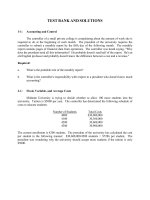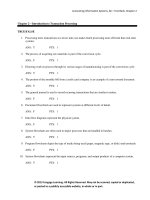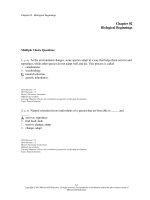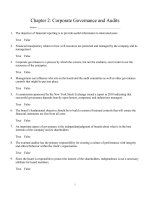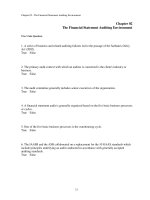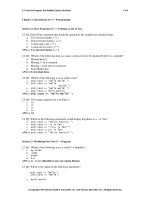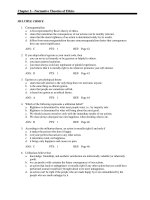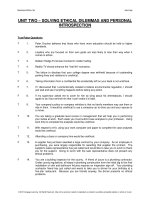Microbiology 8th edition black test bank
Bạn đang xem bản rút gọn của tài liệu. Xem và tải ngay bản đầy đủ của tài liệu tại đây (208.32 KB, 24 trang )
Chapter 2: Fundamentals of Chemistry
Question Type: Multiple Choice
1) Which of the following pairs is mismatched?
a) Protein-amino acids
b) Nucleic acids-nucleotides
c) Polysaccharides – simple sugars
d) Fats-aldehyde
Answer: d
Difficulty: Medium
Learning Objective 1: LO 2.3 Describe the four important types of organic molecules found in
cells.
Section Reference 1: Section 2.4 Complex Organic Molecules
2) A nucleic acid has a “backbone” consisting of:
a) nitrogenous bases
b) sugars
c) phosphates
d) b and c are correct
Answer: d
Difficulty: Easy
Learning Objective 1: LO 2.3 Describe the four important types of organic molecules found in
cells.
Section Reference 1: Section 2.4 Complex Organic Molecules
3) Proteins are chains of ______ that sometimes function as________.
a) disaccharides; cell wall
b) amino acids; enzymes
c) lipids; energy compounds
d) glycogen ; enzymes
Answer: b
Difficulty: Easy
Learning Objective 1: LO 2.3 Describe the four important types of organic molecules found in
cells.
Section Reference 1: Section 2.4 Complex Organic Molecules
4) The total number of protons in an atom is equal to its _____.
a) atomic weight
b) molecular weight
c) chemical weight
d) atomic number
Answer: d
Difficulty: Easy
Learning Objective 1: LO 2.1 Describe the structure of an atom and explain how its structure
functions in elements and chemical bonds.
Section Reference 1: Section 2.2 Chemical Building Blocks and Chemical Bonds
5) Which one of the following pairs is matched correctly?
a) carbon-organic compounds
b) glucose- hydrogen bonds
c) ions-covalent bonds
d) phosphate-enzyme
Answer: a
Difficulty: Hard
Learning Objective 1: LO 2.3 Describe the four important types of organic molecules found in
cells.
Section Reference 1: Section 2.4 Complex Organic Molecules
6) When sodium hydroxide, a strong base, is added to water, the pH of the solution _____.
a) goes up.
b) remains the same.
c) goes down.
d) cannot be determined.
Answer: a
Difficulty: Medium
Learning Objective 1: LO 2.2 Identify important inorganic molecules within cells such as water,
acids, and bases, describing their roles in sustaining life.
Section Reference 1: Section 2.3 Water and Solutions
7) The double helix is a structure associated with:
a) disaccharides
b) a compound with hydrogen bonds
c) lipids
d) DNA
Answer: d
Difficulty: Easy
Learning Objective 1: LO 2.3 Describe the four important types of organic molecules found in
cells.
Section Reference 1: Section 2.4 Complex Organic Molecules
8) In order to become an ion, an atom of chlorine must _____.
a) gain an electron
b) form a covalent bond
c) lose an electron
d) form a hydrogen bond
Answer: a
Difficulty: Medium
Learning Objective 1: LO 2.1 Describe the structure of an atom and explain how its structure
functions in elements and chemical bonds.
Section Reference 1: Section 2.2 Chemical Building Blocks and Chemical Bonds
9) When proteins are made up of several polypeptide chains, the arrangement of these chains is
referred to as the:
a) primary structure
b) secondary structure
c) tertiary structure
d) quaternary structure
Answer: d
Difficulty: Easy
Learning Objective 1: LO 2.3 Describe the four important types of organic molecules found in
cells.
Section Reference 1: Section 2.4 Complex Organic Molecules
10) Two or more atoms combine to form a/an:
a) cation.
b) molecule.
c) protein.
d) ion.
Answer: b
Difficulty: Easy
Learning Objective 1: LO 2.1 Describe the structure of an atom and explain how its structure
functions in elements and chemical bonds.
Section Reference 1: Section 2.2 Chemical Building Blocks and Chemical Bonds
11) Atoms take part in bond formation to:
a) form polypeptides
b) attain a stable electron configuration
c) increase their charge density
d) increase their energy
Answer: b
Difficulty: Medium
Learning Objective 1: LO 2.1 Describe the structure of an atom and explain how its structure
functions in elements and chemical bonds.
Section Reference 1: Section 2.2 Chemical Building Blocks and Chemical Bonds
12) Charged atomswith electrostatic attraction are generally held together by _____.
a) covalent bonds
b) ionicbonds
c) hydrogen bonds
d) municipal bonds
Answer: b
Difficulty: Medium
Learning Objective 1: LO 2.1 Describe the structure of an atom and explain how its structure
functions in elements and chemical bonds.
Section Reference 1: Section 2.2 Chemical Building Blocks and Chemical Bonds
13) The smallest particle of matter that can take part in chemical reactions is:
a) glucose
b) compound
c) neutron
d) atom
Answer: d
Difficulty: Easy
Learning Objective 1: LO 2.1 Describe the structure of an atom and explain how its structure
functions in elements and chemical bonds.
Section Reference 1: Section 2.2 Chemical Building Blocks and Chemical Bonds
14) The three fundamental particles of the atom are _____.
a) elements, molecules, and compounds
b) ions, cations, and anions.
c) proteins, lipids, and sugars
d) protons, neutrons, and electrons.
Answer: d
Difficulty: Easy
Learning Objective 1: LO 2.1 Describe the structure of an atom and explain how its structure
functions in elements and chemical bonds.
Section Reference 1: Section 2.2 Chemical Building Blocks and Chemical Bonds
15) Chemical reactions occur:
a) between elements that have magnetic repulsion.
b) rarely as very few elements have electrons in their outer shell.
c) during metabolism as they are necessary for making the substance of cells.
d) only in eukaryotes as they require a nucleus.
Answer: c
Difficulty: Easy
Learning Objective 1: LO 2.1 Describe the structure of an atom, explaining how its structure
functions in elements and chemical bonds.
Section Reference 1: Section 2.1 Why Study Chemistry?
16) Molecules that contain mixtures of different elements are called _____.
a) isotopes
b) atoms
c) ions
d) compounds
Answer: d
Difficulty: Easy
Learning Objective 1: LO 2.1 Describe the structure of an atom and explain how its structure
functions in elements and chemical bonds.
Section Reference 1: Section 2.2 Chemical Building Blocks and Chemical Bonds
17) The atomic nucleus consists of:
a) cations and anions
b) protons, electrons and neutrons
c) protons and neutrons
d) solutes and colloids
Answer: c
Difficulty: Easy
Learning Objective 1: LO 2.1 Describe the structure of an atom and explain how its structure
functions in elements and chemical bonds.
Section Reference 1: Section 2.2 Chemical Building Blocks and Chemical Bonds
18) Electrons have a _______ charge and are found in the _________.
a) positive; inner electron shell
b) positive; outer electron shell
c) negative; nucleus
d) negative; outer electron shell
Answer: d
Difficulty: Easy
Learning Objective 1: LO 2.1 Describe the structure of an atom and explain how its structure
functions in elements and chemical bonds.
Section Reference 1: Section 2.2 Chemical Building Blocks and Chemical Bonds
19) Chemically stable atoms are inert or less likely to form chemical bonds. A chemically stable
element:
a) has l full outer electron shell
b) has the same number of protons as electrons
c) has an atomic number is equal to the atomic mass
d) forms hydrogen bonds
Answer: a
Difficulty: Medium
Learning Objective 1: LO 2.1 Describe the structure of an atom and explain how its structure
functions in elements and chemical bonds.
Section Reference 1: Section 2.2 Chemical Building Blocks and Chemical Bonds
20) An ion is all of the following except:
a) a charged atom
b) an atom that has lost or gained one or more electrons
c) either a cation or an anion
d) an atom with the same number of protons as electrons
Answer: d
Difficulty: Hard
Learning Objective 1: LO 2.1 Describe the structure of an atom and explain how its structure
functions in elements and chemical bonds.
Section Reference 1: Section 2.2 Chemical Building Blocks and Chemical Bonds
21) In salt, a sodium atom loses an electron to a chlorine atom. What is true about the chloride
ion found in salt?
a) It has one less electron than proton.
b) It is less chemically stable than a chlorine atom.
c) It is an anion.
d) It is in a covalent bond.
Answer: c
Difficulty: Medium
Learning Objective 1: LO 2.2 Identify important inorganic molecules within cells such as water,
acids, and bases, describing their roles in sustaining life.
Section Reference 1: Section 2.3 Water and Solutions
22) What is true about atomic weight?
a) It is the sum of the number of electrons and protons in an atom.
b) The higher the atomic weight the more likely an atom will form a chemical bond.
c) It is always a whole number.
d) Atoms of a particular element that have different atomic weights are called isotopes.
Answer: d
Difficulty: Hard
Learning Objective 1: LO 2.1 Describe the structure of an atom and explain how its structure
functions in elements and chemical bonds.
Section Reference 1: Section 2.2 Chemical Building Blocks and Chemical Bonds
23) Which statement is true for radioisotopes?
a) Radioisotopes have unstable nuclei that emit subatomic particles and radiation.
b) All radioisotopes have gained electrons.
c) Radioisotopes are useful to guard against radioactive elements.
d) Radioisotopes contain particles too large to form true solutions.
Answer: a
Difficulty: Medium
Learning Objective 1: LO 2.1 Describe the structure of an atom and explain how its structure
functions in elements and chemical bonds.
Section Reference 1: Section 2.2 Chemical Building Blocks and Chemical Bonds
24) Food consists of molecules with lots of energy stored in their chemical bonds. What is true
about how microorganisms use nutrients?
a) When microorganisms break the chemical bonds in nutrients, they release energy.
b) It takes microorganisms more energy to break the bonds in nutrients than are released.
c) All energy that microorganisms receive from nutrients comes from anabolism.
d) Microorganisms break down hydrogen bonds to release electrons as energy.
Answer: a
Difficulty: Medium
Learning Objective 1: LO 2.1 Describe the structure of an atom and explain how its structure
functions in elements and chemical bonds.
Section Reference 1: Section 2.2 Chemical Building Blocks and Chemical Bonds
25) Which is a false statement about water?
a) Water molecules are polar.
b) Water has a high specific heat because of the extensive covalent bonding between molecules.
c) Hydrogen atoms in water form dipoles with a partial positive charge.
d) Water’s polarity allows for many ionic compounds to be dissolved in it.
Answer: d
Difficulty: Medium
Learning Objective 1: LO 2.2 Identify important inorganic molecules within cells such as water,
acids, and bases, describing their roles in sustaining life.
Section Reference 1: Section 2.3 Water and Solutions
26) Which is a false statement about chemical reactions?
a) Catabolic reactions are exergonic and release energy.
b) Polymerization and the building up of large molecules is a catabolic reaction.
c) Anabolic reactions require energy.
d) Energy is stored in the form of chemical bonds.
Answer: b
Difficulty: Medium
Learning Objective 1: LO 2.2 Identify important inorganic molecules within cells such as water,
acids, and bases, describing their roles in sustaining life.
Section Reference 1: Section 2.3 Water and Solutions
27) When glucose is dissolved in water, the water is the ________ and the glucose is the
________.
a) solvent, solute
b) solvent, solution
c) solute, solvent
d) solute, solution
Answer: a
Difficulty: Medium
Learning Objective 1: LO 2.2 Identify important inorganic molecules within cells such as water,
acids, and bases, describing their roles in sustaining life.
Section Reference 1: Section 2.3 Water and Solutions
28) Water plays an important role in the chemical reactions in cells, including:
a) denaturing proteins
b) stabilizing the primary structure of a protein
c) forming covalent bonds with proteins
d) breaking down large proteins into amino acids in hydrolysis reactions
Answer: d
Difficulty: Hard
Learning Objective 1: LO 2.2 Identify important inorganic molecules within cells such as water,
acids, and bases, describing their roles in sustaining life.
Section Reference 1: Section 2.3 Water and Solutions
29) Solutions made up of molecules that are not chemically bonded and are not limited to
specific proportions are called:
a) mixtures
b) elements
c) chemical compounds
d) polar compounds
Answer: a
Difficulty: Medium
Learning Objective 1: LO 2.2 Identify important inorganic molecules within cells such as water,
acids, and bases, describing their roles in sustaining life.
Section Reference 1: Section 2.3 Water and Solutions
30) Which of the following statements about solutions is false?
a) The solute is the substance dissolved in a solvent.
b) Left alone on a counter, a solution will separate out.
c) Solutes can consist of atoms, ions or molecules.
d) In cells, water is typically a solvent.
Answer: b
Difficulty: Hard
Learning Objective 1: LO 2.2 Identify important inorganic molecules within cells such as water,
acids, and bases, describing their roles in sustaining life.
Section Reference 1: Section 2.3 Water and Solutions
31) Which of the following is not a colloid?
a) salt water
b) gelatin desserts
c) agar plates used to grow microorganisms
d) fluid in cells
Answer: a
Difficulty: Hard
Learning Objective 1: LO 2.2 Identify important inorganic molecules within cells such as water,
acids, and bases, describing their roles in sustaining life.
Section Reference 1: Section 2.3 Water and Solutions
32) The pH scale is used to specify the acidity or alkalinity of a solution. Which of the following
statements is true?
a) Stomach acid has a pH around 10.
b) Neutral solutions, like water, have a pH of 10.
c) A solution with a pH of 12 has 10 times the number of protons as a solution with a pH of 11.
d) A strong base will have a pH less than 10.
Answer: c
Difficulty: Medium
Learning Objective 1: LO 2.2 Identify important inorganic molecules within cells such as water,
acids, and bases, describing their roles in sustaining life.
Section Reference 1: Section 2.3 Water and Solutions
33) Which statement about acids and bases is false?
a) A hydrogen ion (H+) is a proton.
b) Acids are proton acceptors.
c) Bases are proton acceptors
d) A hydroxyl ion donor is also a proton acceptor
Answer: b
Difficulty: Hard
Learning Objective 1: LO 2.2 Identify important inorganic molecules within cells such as water,
acids, and bases, describing their roles in sustaining life.
Section Reference 1: Section 2.3 Water and Solutions
34) Ketones, alcohols, aldehydes and organic acids are four of the organic compounds found in
all living cells. What do these four classes of organic compounds share?
a) They contain the same atoms but differ in structure.
b) They are chains of carbon atoms with functional groups that contain oxygen.
c) They are all fully oxidized.
d) They can only be synthesized inside a cell.
Answer: b
Difficulty: Hard
Learning Objective 1: LO 2.3 Describe the four important types of organic molecules found in
cells.
Section Reference 1: Section 2.4 Complex Organic Molecules
35) What is true about oxidation?
a) The more oxidized a molecule, the less energy it contains.
b) Oxidation is the removal of oxygen or the addition of hydrogen or electrons to a substance.
c) Gasoline represents the extreme of energy-rich oxidized compounds.
d) Oxidation reactions only occur in polar compounds.
Answer: a
Difficulty: Hard
Learning Objective 1: LO 2.3 Describe the four important types of organic molecules found in
cells.
Section Reference 1: Section 2.4 Complex Organic Molecules
36) Carbohydrates:
a) are hydrophobic.
b) have a four ring structure.
c) are used primarily for energy and cellular structures.
d) have primary, secondary, tertiary and quaternary structure.
Answer: c
Difficulty: Easy
Learning Objective 1: LO 2.3 Describe the four important types of organic molecules found in
cells.
Section Reference 1: Section 2.4 Complex Organic Molecules
37) Glucose:
a) is abundant in milk and fruit
b) is a rare monosaccharide
c) is never produced within cells
d) none of the above
Answer: d
Difficulty: Hard
Learning Objective 1: LO 2.3 Describe the four important types of organic molecules found in
cells.
Section Reference 1: Section 2.4 Complex Organic Molecules
38) Disaccharides, such as sucrose and lactose, are formed from:
a) two monosaccharides connected by a glycosidic bond.
b) chains of two amino acids.
c) long chain of carbon atoms and a carboxyl group at one end of chain.
d) three fatty acids combined with glycerol.
Answer: a
Difficulty: Easy
Learning Objective 1: LO 2.3 Describe the four important types of organic molecules found in
cells.
Section Reference 1: Section 2.4 Complex Organic Molecules
39) Polysaccharides:
a) include ribose, fructose and glucose.
b) include cholesterol and vitamin D.
c) are monosaccharides joined by glycosidic bonds.
d) are found only in eukaryotic cells.
Answer: c
Difficulty: Medium
Learning Objective 1: LO 2.3 Describe the four important types of organic molecules found in
cells.
Section Reference 1: Section 2.4 Complex Organic Molecules
40) Fatty acids that are _________ have ___________ .
a) saturated; lost their secondary structure
b) unsaturated, a double bond between two carbons that have lost hydrogen atoms
c) saturated, one or more double bonds
d) denatured, all the hydrogen it can.
Answer: b
Difficulty: Medium
Learning Objective 1: LO 2.3 Describe the four important types of organic molecules found in
cells.
Section Reference 1: Section 2.4 Complex Organic Molecules
41) Phospholipids:
a) have a charged phosphate group that can mix with water and insoluble fatty acids.
b) can serve as hormones.
c) always remain liquid at room temperature.
d) form straight chains in water.
Answer: a
Difficulty: Medium
Learning Objective 1: LO 2.3 Describe the four important types of organic molecules found in
cells.
Section Reference 1: Section 2.4 Complex Organic Molecules
42) Atoms are most likely to form ions when they have:
a) an even number of electrons in their outer shells
b) a nearly empty outer shell
c) an odd number of electrons in their outer shells
d) four electrons in their outer shells
Answer: b
Difficulty: Medium
Learning Objective 1: LO 2.1 Describe the structure of an atom and explain how its structure
functions in elements and chemical bonds.
Section Reference 1: Section 2.2 Chemical Building Blocks and Chemical Bonds
43) Chemical bonds usually form between atoms through the interaction of:
a) protons
b) neutrons
c) electrons
d) isotopes
Answer: c
Difficulty: Easy
Learning Objective 1: LO 2.1 Describe the structure of an atom and explain how its structure
functions in elements and chemical bonds.
Section Reference 1: Section 2.2 Chemical Building Blocks and Chemical Bonds
44) Chemical bonds found in living organisms do not normally include:
a) ionic bonds
b) hydrogen bonds
c) covalent bonds
d) magnetic bonds
Answer: d
Difficulty: Easy
Learning Objective 1: LO 2.1 Describe the structure of an atom and explain how its structure
functions in elements and chemical bonds.
Section Reference 1: Section 2.2 Chemical Building Blocks and Chemical Bonds
45) When pairs of electrons are shared between two atoms, the result is a/an _______ bond.
a) ionic
b) covalent
c) hydrogen
d) carbonic
Answer: b
Difficulty: Easy
Learning Objective 1: LO 2.1 Describe the structure of an atom and explain how its structure
functions in elements and chemical bonds.
Section Reference 1: Section 2.2 Chemical Building Blocks and Chemical Bonds
46) Hydrogen bonds are generally:
a) stronger than covalent bonds
b) stronger than ionic bonds but weaker than covalent bonds
c) present in large numbers
d) found in non-polar compounds
Answer: c
Difficulty: Easy
Learning Objective 1: LO 2.1 Describe the structure of an atom and explain how its structure
functions in elements and chemical bonds.
Section Reference 1: Section 2.2 Chemical Building Blocks and Chemical Bonds
47) Reactions in which molecules are degraded and energy is released are best termed _____.
a) anabolic
b) catabolic
c) metabolic
d) exerbolic
Answer: b
Difficulty: Easy
Learning Objective 1: LO 2.1 Describe the structure of an atom and explain how its structure
functions in elements and chemical bonds.
Section Reference 1: Section 2.2 Chemical Building Blocks and Chemical Bonds
48) Anabolic reactions tend to:
a) use energy and break chemical bonds.
b) produce energy, and break chemical bonds.
c) produce energy and new chemical bonds.
d) use energy and produce new chemical bonds.
Answer: d
Difficulty: Easy
Learning Objective 1: LO 2.1 Describe the structure of an atom and explain how its structure
functions in elements and chemical bonds.
Section Reference 1: Section 2.2 Chemical Building Blocks and Chemical Bonds
49) Chemical reactions that require energy are best termed _____.
a) catabolic
b) anabolic
c) exergonic
d) endergonic
Answer: d
Difficulty: Medium
Learning Objective 1: LO 2.1 Describe the structure of an atom and explain how its structure
functions in elements and chemical bonds.
Section Reference 1: Section 2.2 Chemical Building Blocks and Chemical Bonds
50) Which of the following pH values would indicate the weakest acid?
a) 2
b) 3
c) 4
d) 5
Answer: d
Difficulty: Easy
Learning Objective 1: LO 2.2 Identify important inorganic molecules within cells such as water,
acids, and bases, describing their roles in sustaining life.
Section Reference 1: Section 2.3 Water and Solutions
51) Organic molecules with the same molecular formula but different structures are:
a) elements
b) isotopes
c) isomers
d) anions
Answer: c
Difficulty: Medium
Learning Objective 1: LO 2.3 Describe the four important types of organic molecules found in
cells.
Section Reference 1: Section 2.4 Complex Organic Molecules
52) Carbohydrates do not include which of the following?
a) Glucose
b) Starch
c) Cellulose
d) Sterols
Answer: d
Difficulty: Medium
Learning Objective 1: LO 2.3 Describe the four important types of organic molecules found in
cells.
Section Reference 1: Section 2.4 Complex Organic Molecules
53) Amino acids in a protein are joined together by _____.
a) peptide bonds
b) hydrogen bonds
c) phosphodiester bonds
d) tertiary bonds
Answer: a
Difficulty: Easy
Learning Objective 1: LO 2.3 Describe the four important types of organic molecules found in
cells.
Section Reference 1: Section 2.4 Complex Organic Molecules
54) The specific sequence of amino acids in a protein is known as its:
a) primary structure
b) secondary structure
c) tertiary structure
d) quaternary structure
Answer: a
Difficulty: Easy
Learning Objective 1: LO 2.3 Describe the four important types of organic molecules found in
cells.
Section Reference 1: Section 2.4 Complex Organic Molecules
55) In DNA, the nucleotide cytosine always base pairs to:
a) adenine
b) guanine
c) thymine
d) uracil
Answer: b
Difficulty: Medium
Learning Objective 1: LO 2.3 Describe the four important types of organic molecules found in
cells.
Section Reference 1: Section 2.4 Complex Organic Molecules
56) Which of the following is a three carbon sugar alcohol?
a) a
b) b
c) c
d) d
Answer: c
Difficulty: Easy
Learning Objective 1: LO 2.3 Describe the four important types of organic molecules found in
cells.
Section Reference 1: Section 2.4 Complex Organic Molecules
57) How many electrons are in the first shell of the sodium atom?
a) one
b) two
c) four
d) six
Answer: b
Difficulty: Medium
Learning Objective 1: LO 2.1 Describe the structure of an atom and explain how its structure
functions in elements and chemical bonds.
Section Reference 1: Section 2.2 Chemical Building Blocks and Chemical Bonds
58) How many electrons are in the second shell of the chlorine atom?
a) two
b) four
c) eight
d) ten
Answer: c
Difficulty: Medium
Learning Objective 1: LO 2.1 Describe the structure of an atom and explain how its structure
functions in elements and chemical bonds.
Section Reference 1: Section 2.2 Chemical Building Blocks and Chemical Bonds
59) Which of the following has the fewest hydroxyl ions?
a) Oven cleaner
b) Household bleach
c) Saliva
d) Vinegar
Answer: d
Difficulty: Medium
Learning Objective 1: LO 2.2 Identify important inorganic molecules within cells such as water,
acids, and bases, describing their roles in sustaining life.
Section Reference 1: Section 2.3 Water and Solutions
60) Which of the following has the fewest hydrogen ions?
a) Stomach hydrochloric acid
b) Urine
c) Ocean water
d) Household ammonia
Answer: d
Difficulty: Medium
Learning Objective 1: LO 2.2 Identify important inorganic molecules within cells such as water,
acids, and bases, describing their roles in sustaining life.
Section Reference 1: Section 2.3 Water and Solutions
Question Type: Essay
61) Describe the formation and importance of a hydrogen bond. Why is water the universal
dissolving medium (e.g., solvent) of life? Name two roles water plays in cells.
Answer: A hydrogen bond is a special type of bond that forms between a proton that has a partial
positive charge because of a bond to atoms that strongly attract electrons (e.g., oxygen or
nitrogen) and another atom that has a partial negative charge. This type of bond always involves
a hydrogen atom. The hydrogen bond is important because it is found between water molecules
and because in large numbers they contribute to the structure of large molecules such as proteins
or nucleic acids.
Water is essential to life because water can act as a dissolving medium or solvent. Water is a
good solvent because the polar water molecules surround ions. In other words, many different
kinds of ions can be distributed evenly throughout water because water is polar.
Water plays the following roles in cells: it keeps them moist by forming a thin film of water
(surface tension), it is an ideal medium for most chemical reactions being able to donate protons
and hydroxyl ions, its polarity allows many different ions to be dissolved in cells, it contributes
to the structure of large molecules such as proteins or nucleic acids, it participates in dehydration
synthesis and hydrolysis reactions.
Difficulty: Medium
Learning Objective 1: LO 2.2 Identify important inorganic molecules within cells such as water,
acids, and bases, describing their roles in sustaining life.
Section Reference 1: Section 2.3 Water and Solutions
62) Energy is an important chemical currency. How does energy affect electrons in the atom?
What is the role of energy in a chemical bond? Name two complex organic molecules that are
used by cells for energy. How does the cell release this energy?
Answer: Electrons can have different levels of energy. Electrons with the least energy are
located nearest the nucleus and those with more energy are located farther away from the nucleus
(and are most likely to interact to form bonds with other atoms).
Energy associated with chemical bonds hold the atoms together forming molecules. It is the
energy from sharing the electrons that allow two atoms to form chemical bonds.
The cell uses fats, sugars and proteins for energy and energy storage. The cell releases this
energy by breaking down complex molecules (macromolecules) into simple molecules. For
example, polysaccharides are broken down into monosaccharides. Proteins can be broken down
into amino acids. The cell releases this energy by breaking down high energy bonds that form
within these chemicals- these bonds are most commonly between carbon and hydrogen atoms.
Enzymes are needed to catalyze the breaking of these bonds. If a molecular structure is very
complex and too many enzymatic steps are needed for the molecule to be degrade, no net energy
will be gained by the cell. This is why nucleic acids are not used by cells for energy yield.
Difficulty: Medium
Learning Objective 1: LO 2.3 Describe the four important types of organic molecules found in
cells.
Section Reference 1: Section 2.4 Complex Organic Molecules
63) Describe the chemical composition, type/structure and function for the following complex
organic molecules: carbohydrates, lipids, proteins, DNA and RNA
Answer: Carbohydrates are simple sugars or polymers known as polysaccharides such as starch,
glycogen and cellulose. The carbon atoms may be associated with alcohols or a ketone or
aldehyde group. Microbes use carbohydrates for immediate energy, storage of energy and cell
wall components.
Lipids are organic molecules that are insoluble in water. Many are polymers composed of
glycerol bound to two or more fatty acids. They include fats, phospholipids and steroids. They
are used for energy storage and cell membrane components.
Proteins consist of chains of amino acids linked by peptide bonds. They form part of the
structure of all cellular components and act as enzymes and defense molecules.
DNA and RNA are composed of chains of nucleotides (formed of nitrogenous base, sugar,
phosphates). DNA molecules form double stranded helixes. RNA is usually single stranded.
DNA and RNA serve as the genetic material (information encoding proteins) for all life forms
and play a role in genetic expression as well.
Difficulty: Medium
Learning Objective 1: LO 2.3 Describe the four important types of organic molecules found in
cells.
Section Reference 1: Section 2.4 Complex Organic Molecules
